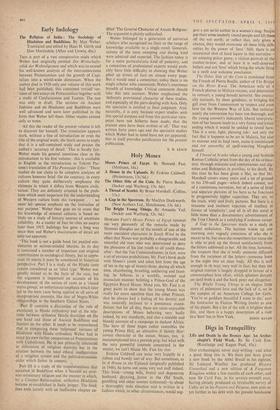Holy . Moses Moses Prince of Egypt. By Howard Fast. (Methuen,
16s.) A House in the Uplands. By Erskine Caldwell. (Heinemann, 13s,6d.) The Other Side of the Coin. By Pierre Boulle. (Seeker and Warburg, 13s. 6d.) A Gap in the Spectrum. By Marilyn Duckworth.
(New Authors Ltd., Hutchinson, 13s. 6d.) The Bright Young Things. By Amanda Vail.
(Seeker and Warburg, 12s. 6d.)
HOWARD Fasr's Moses Prince of Egypt reminds me very pleasantly of the remarks made by
Norman Douglas out of the mouth of one of the
more succulent characters in South Wind to the effect that Moses was probably a disagreeable and
resentful old man who was determined to deny the pleasures of his lost youth to all youth there- after : that the Ten Commandments, in fact, were a set of envious prohibitions. Mr. Fast's book deals with Moses's youth and takes him from the age of ten to the age of twenty-three, during all which
time, chambering, brawling, soldiering and feast- ing, he behaves in a worldly, monied and insouciant manner befitting a Prince-God of the Egyptian Royal House. Mind you, Mr. Fast is at great pains to show that the young Moses was really far more sensitive than the other Princes, that he always had a feeling of his destiny and was naturally inclined to a passionate mono- theism; but for all this, there are some enjoyable descriptions of Moses behaving very badly indeed, by any standards, and also a notable and bloody account of a campaign in darkest Africa. The hero of these pages rather resembles the young Prince Hal; an attractive if faintly .Har- rovian character at the outset, Moses, too, is metamorphosed into a peevish prig; but what with the very powerful interests concerned in the matter, we can't blame Mr. Fast for that.
Erskine Caldwell can write very happily in a robust and bawdy sort of way. But sometimes, as in A House in the Uplands (originally published in 1946), 'he turns out some very sad stuff indeed. This book—young wife, brutal and degenerate husband, decaying house in the Old South, gambling and other women (coloured)-As about a thoroughly stale situation and is written in a fashion which, in other circumstances, would sug- gest a pet serial author in a women's mag. People put their arms tenderly round people and lift them off the wet earth; or reflect that, only given a chance, they would overcome all these little diffi- culties by the power of 'love.' Still, there is an occasional shot of hard liquor in this narrative— an amusing poker game, a vicious portrait of the mother-in-law; and at` least it is well-deserved bullets and not 'love' which bring the whole thing to a swift and welcome conclusion.
The Other Side of the Coin is translated from the French of Pierre Boulle, author of The Bridge on the River Kwai. The American wife of a French planter in Malaya rescues, and determines to convert, 'a young female terrorist. She eventu- ally succeeds, by sheer goodness, in bringing the girl over from Communism to respect and even love for the Western Way of Life. But unfortu- nately the conversion has been too thorough, and the young convert's indecently liberal interpreta- tion of her lessons leads to a very funny and ironic ending which it would be unkind to reveal here. This is a neat, light, pleasing tale: not only the fact that it happens to be set in Malaya, but also its manner and its final twist, make it reminiscent and not unworthy of spell-weaving Maugham himself.
A Thread of Scarlet takes a young and Scottish. Roman Catholic priest from the day of his ordina- tion, through missions and controversies and dig- nities and Bishoprics in partibus, to his death. By this time he has been given a Hat, so that Mr. Marshall covers many years and a lot of ground in his 250-odd pages—which indeed consist, not of a continuous narration, but of a series of brief and separate pictures of his hero as he functions in progressively higher capacities. They are, in the main, witty and lively pictures. But there is a tiresome and insistent rejection of intellect in favour of `simplicity'; and all in all this novel is little more than a documentary advertisement of the True Church as a satisfying if arduous career.
A Gap in the Spectrum starts as a study in mental unbalance. The heroine wakes up one morning only vaguely conscious of who she is meant to be, but since she remembers her name she , is able to pick up the thread satisfactorily from the letters addressed to her. All the time, however, she suspects that she is really someone different from the recipient of the letters—someone born in the night into an alien body. All this is well enough in its way, very well in fact, but then the original interest is largely dropped in favour of a commonplace love affair, which splutters damply on until both it and the book peter out altogether.
The Bright Young Things is an elegiac little story of pubescent love and the lack of it, set in the campus of an American College for Girls. 'You're so goddam beautiful I want to die,' says the Instructor in Fiction Writing (male) to one of his pupils. But a lot of the talk is brighter than this, and there is a happy description of a visit to a 'beat' bar in New York. SIMON RAVEN


































 Previous page
Previous page